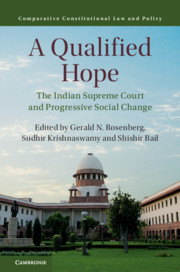Book contents
- A Qualified Hope
- Comparative Constitutional Law and Policy
- A Qualified Hope
- Copyright page
- Contents
- Notes on Contributors
- Foreword
- Acknowledgments
- Introduction
- Part I The Supreme Court of India – An Institutional Overview
- Part II The Supreme Court of India, Social and Political Mobilization
- Part III Welfare Rights and the Environment
- Part IV Discrimination
- 11 The Polarizing Face of Law
- 12 Evaluating the Impact of the Indian Supreme Court Judgment on Sex-Selective Abortion
- Conclusion
- References
12 - Evaluating the Impact of the Indian Supreme Court Judgment on Sex-Selective Abortion
from Part IV - Discrimination
Published online by Cambridge University Press: 19 August 2019
- A Qualified Hope
- Comparative Constitutional Law and Policy
- A Qualified Hope
- Copyright page
- Contents
- Notes on Contributors
- Foreword
- Acknowledgments
- Introduction
- Part I The Supreme Court of India – An Institutional Overview
- Part II The Supreme Court of India, Social and Political Mobilization
- Part III Welfare Rights and the Environment
- Part IV Discrimination
- 11 The Polarizing Face of Law
- 12 Evaluating the Impact of the Indian Supreme Court Judgment on Sex-Selective Abortion
- Conclusion
- References
Summary
We examine the impact of the Supreme Court judgment on sex-selective abortion. In the 1980s, the Indian child sex ratio, a ratio comparing the number of male Indian children to female Indian children, began to shift significantly towards a male skew. As ultrasounds became widely available in India, many women used them to determine the future sex of their fetuses and to abort female fetuses. In response, the Indian Parliament prohibited medical professionals from revealing the future sex of the fetus to women in 1994. In 2003, the Indian Supreme Court responded to a public interest litigation petition by pushing for amendment and greater enforcement of the Act. We examine the sex ratio data with 1998, before the Indian Supreme Court’s decision in 2003, and ending in 2008. Our data draw from two large-scale nationally representative cross-sectional household surveys covering all districts of India. We compare these data to the average annual probability of female-births among all ever born children from the same time period. The sex ratio continued to become more male-skewed after the Court’s decision.
Keywords
- Type
- Chapter
- Information
- A Qualified HopeThe Indian Supreme Court and Progressive Social Change, pp. 319 - 344Publisher: Cambridge University PressPrint publication year: 2019



